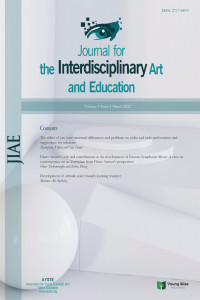Formal analysis of Fikret Amirov's violin work named Mugham Poema
Formal analysis of Fikret Amirov's violin work named Mugham Poema
Azerbaijani music has developed itself for centuries and has given the best examples of the combination of folk music elements with contemporary music. Fikret Amirov, one of the most important representatives of this combination, was the creator of "Eastern Symphonism". Fikret Amirov composed important works during his lifetime, performed and directed his works in Azerbaijan and in different countries of the world. “Mugham Poema”, which was composed by Fikret Amirov has an important place both in Azerbaijani instrumental music and in the composer's career as it was the first work he wrote for violin. In this study, Fikret Amirov's "Mugham Poema", one of the composers of the contemporary period, is analyzed in detail, his musical life is briefly mentioned and information about mugham is given. The aim of the study is to analyse the form of “Mugham Poema” and its formal structer. The data obtained in this direction shows that the composer mastered all the technical equipment of the violin and masterfully used the art of mugham in his work, which was composed in the western form. In this study, firstly, the data was reviewed through a literature review, and then a detailed analysis was made on the score. As a result of the study, it was revealed that Fikret Amirov wrote “Mugham Poema” by combining the elements of mugham with the characteristics of the poem genre, composed it in a form that is a combination of eight sections with several introductions and coda, and combined the work with more than one section into a single composition.
Keywords:
Azerbaijani music, Fikret Amirov, Form analysis, Mugham Poema Violin,
___
- Ahmadov, K. (2021). Comparative analysis of segâh and çargâh/çahargâh makams in Azerbaijani mugham and Turkish makam music. Master's Thesis. Selcuk University Institute of Social Sciences: Konya.
- Ganbarlı, A. (2019). Analyzing the Azerbaijani maqams used by Fikret Amirov in his work "12 miniatures". Master's Thesis.Mimar Sinan University Institute of Fine Arts: Istanbul.
- Garibova, J. (1997). Folk melodies and symphonic masterpieces, Azerbaijan International, 5(4), 54-58.
- Gurbanov, V. (2021). Fikret Amirov, his life, his works and technical and interpretive analysis of his composition "4 pieces" for violin. Proficiency in Art Thesis. Mimar Sinan University Institute of Fine Arts: Istanbul.
- Hacıbeyli, Ü. (1985). Fundamentals of Azerbaijan Folk Music. Bakı: Yazici Neshriyati.
- Karataş, Z. (2015). Qualitative research methods ın the social sciences. Manevi Temelli Sosyal Hizmet Araştırmaları Dergisi, 1(1) 62-80.
- Kiymetli, B. (2019). Nazım Hikmet Ran and Fikret Amirov in the Changes in Music and Literature Influenced By Political Systems. Journal of Academic Social Research, 7(87), 383-390.
- Mirzayeva, S. (1978). Fikret Amirov. Yazici Publishing House. Qasımova S., and Abdullayeva, Z. (2004). Fikrat Amirov. Ministry of Culture of the Republic of Azerbaijan: Baku.
- Rzayeva, B. (2020). Notation History of Azerbaijani Mugam Heritage. Journal of Cultural Studies, 6, 243-252.
- Tehmirazqızı, S. (2005). Fikrət Amirov. Ministry of Culture and Tourism of the Republic of Azerbaijan: Baku.
- Türkmenoğlu, Ö., and Deniz, Z. (2022). Fikret Amirov's role and contributions in the development of Eastern Symphonic Music: A view on contemporary art in Azerbaijan from Fikret Amirov's perspective. Journal for the Interdisciplinary Art and Education, 3(1), 19-28.
- Vinogradov, V. (1983). Fikret's music world. Yazici Publishing House.
- Yayın Aralığı: Yılda 4 Sayı
- Başlangıç: 2020
- Yayıncı: Genç Bilge Yayıncılık
